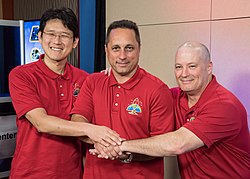Sojus MS-07
| Missionsdaten | |||
|---|---|---|---|
| Mission | Sojus MS-07 | ||
| NSSDCA ID | 2017-081A | ||
| Raumfahrzeug | Sojus 7K-MS (GRAU-Index 11F732) Seriennummer 737 | ||
| Rufzeichen | Астрей („Astraios“) | ||
| Trägerrakete | Sojus FG (GRAU-Index 11A511FG) | ||
| Besatzung | 3 | ||
| Start | 17. Dezember 2017, 07:21 UTC | ||
| Startplatz | Baikonur 1/5 | ||
| Raumstation | ISS | ||
| Andockplatz | Rasswet | ||
| Ankopplung | 19. Dezember 2017, 08:39 UTC | ||
| Abkopplung | 3. Juni 2018, 09:16 UTC | ||
| Dauer auf ISS | 166d 0h 37min | ||
| Landung | 3. Juni 2018, 12:39 UTC | ||
| Landeplatz | 156 km SÖ von Schesqasghan, Kasachstan | ||
| Flugdauer | 168d 5h 18min | ||
| Erdumkreisungen | 2688 | ||
| Mannschaftsfoto | |||
 Norishige Kanai, Anton Schkaplerow und Scott Tingle | |||
| ◄ Vorher / nachher ► | |||
| |||
Sojus MS-07 ist eine Missionsbezeichnung für den Flug des russischen Raumschiffs Sojus zur Internationalen Raumstation. Im Rahmen des ISS-Programms trägt der Flug die Bezeichnung ISS AF-53S. Es ist der 53. Besuch eines Sojus-Raumschiffs an der ISS und der 159. Flug im Sojusprogramm.
Besatzung
Hauptbesatzung
- Anton Nikolajewitsch Schkaplerow (3. Raumflug), Kommandant (Russland/Roskosmos)
- Norishige Kanai (1. Raumflug), Bordingenieur (Japan/JAXA)
- Scott Tingle (1. Raumflug), Bordingenieur (USA/NASA)
Ersatzmannschaft
- Sergei Walerjewitsch Prokopjew (1. Raumflug), Kommandant (Russland/Roskosmos)
- Alexander Gerst (2. Raumflug), Bordingenieur (Deutschland/ESA)
- Jeanette Epps (1. Raumflug), Bordingenieurin (USA/NASA)
Missionsbeschreibung
Die Mission brachte drei Besatzungsmitglieder der ISS-Expeditionen 54 und 55 zur Internationalen Raumstation. Der Flug war ursprünglich für den 27. Dezember 2017 geplant. Die NASA bat Roskosmos jedoch um eine Vorverlegung, um kein Personal über die Weihnachtsfeierlichkeiten in Baikonur vorhalten zu müssen. Allerdings befand sich die ISS nun auf einer Flugbahn, die nicht für den kurzen „Expressanflug“ geeignet war. Deshalb griff man für diese Mission wieder auf den klassischen Zweitagesanflug zurück.[1]
Das Abdocken erfolgte am 3. Juni 2018 um 09:16 UTC, damit begann auf der Station die ISS-Expedition 56 mit Andrew Feustel als Kommandant. Die Landung erfolgte am selben Tag ca. 3 ½ Stunden später in der kasachischen Steppe 147 km südöstlich von Scheskasgan.
Galerie
- Der Rollout der Rakete am 15. Dezember 2017
- Der Start am 17. Dezember
- Das Raumschiff an der ISS am 24. März 2018
- Die Landekapsel am Fallschirm am 3. Juni 2018
- Die Crew mit den Helfern kurz nach der Landung
Siehe auch
- Liste der Sojus-Missionen
- Liste der bemannten Missionen zur Internationalen Raumstation
- Liste der bemannten Raumflüge
Weblinks
- Sojus MS-07 bei spacefacts.de
- Sojus MS-07 im Russian Space Web
- Sojus MS-07 in der Encyclopedia Astronautica (englisch)
- Sojus MS-07 im NSSDCA Master Catalog (englisch).
Einzelnachweise
- ↑ Soyuz MS-07 crew begins two-day trek toward ISS. Spaceflight Insider, 17. Dezember 2017, abgerufen am 17. Dezember 2017 (englisch).
Auf dieser Seite verwendete Medien
The Soyuz rocket is rolled out by train to the launch pad, Friday, Dec. 15, 2017 at the Baikonur Cosmodrome in Kazakhstan. Expedition 54 Soyuz Commander Anton Shkaplerov of Roscosmos, flight engineer Scott Tingle of NASA, and flight engineer Norishige Kanai of Japan Aerospace Exploration Agency (JAXA) are scheduled to launch at 2:21 a.m. Eastern Time (1:21 p.m. Baikonur time) on Dec. 17 and will spend the next five months living and working aboard the International Space Station. Photo Credit: (NASA/Joel Kowsky)
Japan Aerospace Exploration Agency (JAXA) astronaut Norishige Kanai, left, Roscosmos cosmonaut Anton Shkaplerov, center, and NASA astronaut Scott Tingle sit in chairs outside the Soyuz MS-07 spacecraft after they landed in a remote area near the town of Zhezkazgan, Kazakhstan on Sunday, June 3, 2018. Shkaplerov, Tingle, and Kanai are returning after 168 days in space where they served as members of the Expedition 54 and 55 crews onboard the International Space Station.
A Soyuz-FG launch vehicle launched the Soyuz MS-07 spacecraft with International Space Station Expedition 54 crew members NASA astronaut Scott Tingle, Roscosmos cosmonaut Anton Shkaplerov and JAXA astronaut Norishige Kanai, from the Baikonur Cosmodrome in Kazakhstan, on 17 December 2017, at 07:21 UTC (13:21 local time).
Scott D. Tingle: "We enjoyed answering your questions yesterday at our Expedition 54/55 crew press conference. I am honored to be part of such a great crew!"
The Soyuz MS-07 rocket is launched with Expedition 54 Soyuz Commander Anton Shkaplerov of Roscosmos, flight engineer Scott Tingle of NASA, and flight engineer Norishige Kanai of Japan Aerospace Exploration Agency (JAXA), Sunday, Dec. 17, 2017 at the Baikonur Cosmodrome in Kazakhstan. Shkaplerov, Tingle, and Kanai will spend the next five months living and working aboard the International Space Station. Photo Credit: (NASA/Joel Kowsky)
The Soyuz MS-07 spacecraft that launched three Expedition 54/55 crew members to the International Space Station on Dec 17 2017 is pictured docked to the Rassvet module.
Backdropped by a blanket of clouds, the Soyuz TMA-7 spacecraft departs from the International Space Station carrying astronaut William S. (Bill) McArthur Jr., Expedition 12 commander and NASA space station science officer; Russian Federal Space Agency cosmonaut Valery I. Tokarev, flight engineer; and Brazilian Space Agency astronaut Marcos C. Pontes. Undocking occurred at 2:48 p.m. (CDT) on April 8.
The Soyuz MS-07 spacecraft is seen as it lands with Expedition 55 crew members Anton Shkaplerov of Roscosmos, Scott Tingle of NASA, and Norishige Kanai of the Japan Aerospace Exploration Agency (JAXA) near the town of Zhezkazgan, Kazakhstan on Sunday, June 3, 2018. Shkaplerov, Tingle, and Kanai are returning after 168 days in space where they served as members of the Expedition 54 and 55 crews onboard the International Space Station.















